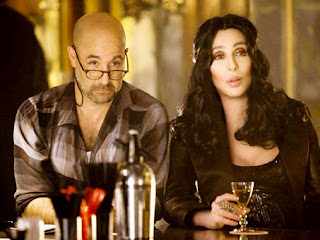 I loved this movie. I loved the dancing, the singing and story.
I loved this movie. I loved the dancing, the singing and story.The movie belongs to Christina Aquilera. She is fabulous. Some critics have said that she is the best female vocalist today.
Now she proves that she can dance and sing.
This is not the kind of musical where people go walking down the street singing to each other. The is a true follies, like you may see in Las Vegas. Or like you may have been fortunate to see in the 50's, 60's, or until the end of Burlesque in most major cities. I was lucky enough to have my Dad take me to see Sally Rand, the famous fan dancer when she was in Minneapolis. Her famous fan dance is performed in the film by Aquilera.
Cher has top billing. And she has earned it. She only sings two songs in the movie, but they show Cher at her best.
In the movie she plays Tess, the older owner of the club. Ali, a young wantabe from Iowa hangs in there until she has a chance to strut and sing what she has been waiting for. And she succeeds.
Stanley Tucci, as always is great as the main sidekick of Tess, who gives his all to the























































